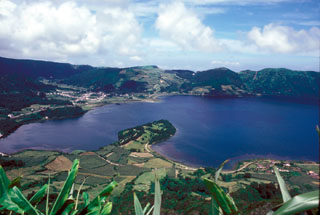Report on Sete Cidades (Portugal) — September 1998
Bulletin of the Global Volcanism Network, vol. 23, no. 9 (September 1998)
Managing Editor: Richard Wunderman.
Sete Cidades (Portugal) Seismic swarm on submarine flank
Please cite this report as:
Global Volcanism Program, 1998. Report on Sete Cidades (Portugal) (Wunderman, R., ed.). Bulletin of the Global Volcanism Network, 23:9. Smithsonian Institution. https://doi.org/10.5479/si.GVP.BGVN199809-382080
Sete Cidades
Portugal
37.865°N, 25.785°W; summit elev. 842 m
All times are local (unless otherwise noted)
Since June 1998, increasing seismic activity in the vicinity of Sete Cidades volcano has resulted in occasional seismic swarms. On the night of 2-3 August about 120 events were registered in 3 hours. During that period, five earthquakes were felt along the W coast, the strongest with a magnitude of 3.1 reached a maximum intensity of V (MM) at Ginetes e Varzea. Similarly, on 2 September in Sao Miguel more than 120 events occurred beneath the sea floor over a period of about 4 hours near shore between Ponta da Ferraria and Mosteiros. One of the five felt earthquakes during this period also reached an intensity of V (MM). There were no reports of injury or damage from any of these events.
Geological Summary. Sete Cidades volcano at the western end of Sao Miguel Island contains a 5-km-wide summit caldera occupied by two caldera lakes. The steep-walled, 500-m-deep caldera was formed about 22,000 years ago, and at least 22 post-caldera eruptions have occurred. A large group of Pleistocene post-caldera trachytic lava domes, lava flows, and pyroclastic-flow deposits is found on the western-to-northern flanks. A nearly circular ring of six Holocene pyroclastic cones on the caldera floor have been the source of a dozen trachytic pumice-fall deposits erupted during the past 5,000 years. Recorded eruptions date back to the 15th century and have occurred both within the caldera and from submarine vents off the west coast.
Information Contacts: João Luis Gaspar and Nicolau Wallenstein, Departamento de Geociencias, Centro de Vulcanologia, Universidade dos Açores, Rua Mae de Deus, 9500 - Ponta Delgada, Sao Miguel, Açores, Portugal.

